Implication of obesity-induced miR-96 in hepatic insulin resistance
DOI: 10.14800/rd.1615
Abstract
Obesity is a serious health problem that is caused by an equilibrium shift towards elevated energy intake over expenditure, and is often involved in a range of metabolic diseases. A diet rich in saturated fatty acids (SFA), which is one of the leading causes of obesity and ectopic lipid accumulation in the key organs for metabolic regulation, results in an imbalance of the cellular metabolism and an inadequate response of hepatocytes to insulin, which is known as hepatic insulin resistance. Although endogenous non-coding small microRNAs (miRNAs) play important roles in the post-transcriptional repression of the target genes, the implications of obesity-induced miRNAs in metabolic diseases, particularly in the development of hepatic insulin resistance, are largely unknown. In recent studies, SFA and a high fat diet were found to increase the expression of certain miRNAs significantly in the liver and skeletal muscle. These obesity-induced miRNAs were also up-regulated in human subjects with metabolic diseases. Our recent study highlights a novel mechanism whereby miR-96, which is one of the obesity-induced miRNA, participates actively in the development of hepatic insulin resistance in obesity. Studies focusing on obesity-induced miR-96 have indicated the strong diagnostic and therapeutic importance of miRNAs in insulin resistance and metabolic diseases. This will also help better understand the pathogenesis of insulin resistance and T2DM in obesity, and enable the development of inhibitors against obesity-induced miRNAs as a novel diagnostic and therapeutic strategy for metabolic diseases.












